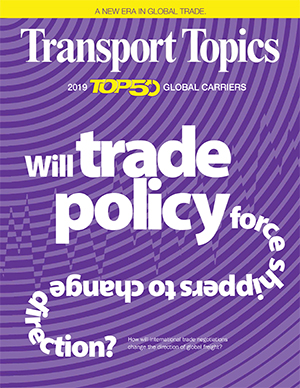Special to Transport Topics
Netherlands Takes Tech-Forward Approach to Transporting Freight by Land, Sea and Air
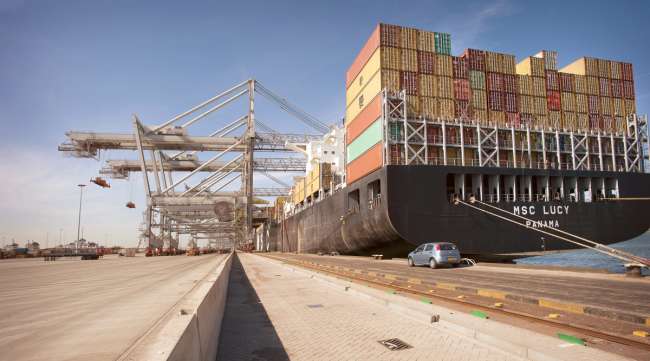
[Stay on top of transportation news: Get TTNews in your inbox.]
AMSTERDAM — To keep pace with growing cargo volumes and more stringent delivery requirements, some of the world’s most advanced freight handlers have been making significant headway in areas such as data, digitization, connectivity, automation and sustainability.
Those elements smoothly meld together in the Netherlands, the self-dubbed “Gateway to Europe.” This small country is a big player on the freight scene and is considered one of the most prominent logistics hubs for products entering and exiting the European Union.
The World Economic Forum’s 2019 Global Competitiveness Report ranked the Netherlands’ economy as the most competitive in Europe, and the fourth most competitive of the 141 countries examined worldwide. The country received Europe’s highest score for transportation infrastructure and the second highest score in the world, following Singapore. The Netherlands also was listed as the top European country for sea and air transportation efficiency.
Dutch industry and public entities alike are taking a comprehensive approach to continue this momentum and improve freight operations for the betterment of the entire supply chain, within the EU and globally.
To move all the freight that crosses its borders, the Netherlands relies on an extensive multimodal network that includes road, rail, air and sea.
The lion’s share of imported products enters the country through the Port of Rotterdam or Amsterdam Airport Schiphol for distribution throughout the EU.
Rotterdam, the largest seaport in Europe, handled more than 14.5 million shipping containers in 2018. After multiple rounds of expansion through dredging, it now covers 41 square miles, and further expansion is projected in the coming decade.
A nagging challenge is to efficiently distribute the growing volume of containers coming into the port throughout the EU because other countries’ infrastructures don’t always keep pace with that of the Netherlands. But the port has put in place measures to counteract resulting bottlenecks via process improvements at its terminals.
Another challenge arises when water levels are low and ships — especially deep-sea ships — have difficulty docking. In those circumstances, more goods flow back to trucking.
Schiphol, meanwhile, is the EU’s fourth largest airport in terms of cargo volume, according to the Airports Council International. It handled 1.7 million metric tons of cargo in 2018 on 31 freighter lines.
But Schiphol has reached the maximum of 500,000 air transport movements allowed per year by the federal government, and therefore is working to increase capacity, in part by putting more air cargo onto passenger flights.
The airport currently is in negotiations to increase the movements by 40,000 annually after November 2020.
Still, the intention is not to overtake the rest of the EU air cargo market, but rather to focus on quality.
“We don’t want to be the biggest, we want to be the preferred,” said Bart Pouwels, head of cargo at Amsterdam Airport Schiphol.
Beyond the capacity restrictions, another growing challenge is a change in the type of freight that comes through the airport. Schiphol faces a “tsunami of individual parcels” that each have low commodity values, compared to traditional high-value bulk freight, Pouwels said.
E-commerce has proven a game changer in that regard.
The Advance of Automation
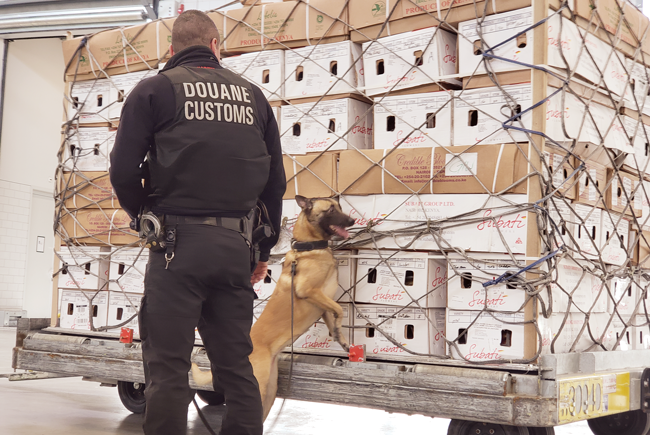
Amsterdam's Schiphol airport has implemented digital cargo inspection and monitoring, but trained customs employees — and dogs — remain essential. (Katie Pyzyk for Transport Topics)
The rise of e-commerce also has created higher expectations for delivery. Increased demand for next-day or two-day shipments has created extra incentive for automated processes that provide efficiency gains and long-term cost savings.
Veghel-based Vanderlande fills a lot of that demand as the world’s fifth-largest material handling supplier and logistics automation company.
The future of logistics lies in technology trends that include sensors, robotics and automation, along with digitization and cloud computing and storage, said Erik de Jonge, Vanderlande’s manager of market strategy. Integrating those elements to create flexible infrastructure — automated systems that can be implemented, moved and expanded quickly — keeps customers ahead of the game.
He estimates that the warehouse automation market has doubled in the past five years. Robotic palletizers, for example, are gaining popularity among grocery companies. The equipment uses an algorithm based on load-forming logic to stack a variety of different items intended for the same store onto one pallet, akin to a game of Tetris. The system prioritizes weights from heaviest to lightest as well as product dimensions, fragility and store layout for optimal shelf replenishment.
Automated systems reach into the e-commerce world with robotic parcel sortation and packing solutions. For example, Vanderlande manufactures a robotic arm that picks up individual items from a conveyor with vacuum suction and deposits them into the correct packaging for distribution. As part of a larger system, such robotic sorting elements are expected to gain more widespread adoption soon at large fulfillment centers.
The Netherlands largely views automation as a solution rather than a threat to jobs, de Jonge said. Employees are becoming less needed in picking and packing jobs, but more valuable when transitioned to jobs involving data, process optimization, supervision, customer service centers, equipment engineering and research and development. Similar to logistics and freight-focused businesses throughout the Netherlands, Vanderlande therefore seeks more highly educated and skilled employees than in the past.
Rhenus Logistics is undergoing a similar shift as it increases the automation in its freight handling and warehousing processes. It employs an autonomous grid system in a portion of its new warehouse facility in Tilburg, which houses 650,000 square feet of storage space.
Wheeled robots receive order information and drive on an overhead grid to pick up products from one of the 21,000 storage bins. Making the storage inaccessible to humans at the ground level allows it to be condensed due to a lack of aisles or walkways. The robots transport the selected items to the packing center.
“We are the first [facility] to have this system. If it is successful we will roll it out to other warehouses,” said Alphons van Erven, senior vice president of Rhenus Logistics.
Business owners frequently mention automation and robotics as the greatest and most transformative trend for the future of freight and logistics. But there are instances where it is not considered the optimal way of doing business.
While certain global e-commerce distribution centers dabble with forms of automation such as robots to fill boxes or drones to move products from shelves to boxing stations, others do not believe the hefty, up-front capital investment for customized equipment yields enough return on investment.
That’s the case for Bleckmann’s fashion distribution center in Venlo. It handles order fulfillment and distribution for well-known brands including Fabletics, EMU, Coach and Lululemon.
E-commerce brands often do not enter into long-term contracts with distribution centers. Instead, those contracts average three to five years. That prevents distributors from realizing a return on investment with automation, which often takes 10 years or longer to achieve. Installing an automated system that meets one customer’s needs could be obsolete if that customer exits the facility a few years later.
“We’re more flexible in this environment than in a fully automated one. When one customer goes under, another one can easily go into the space,” said Jurrie-Jan Tap, Bleckmann’s chief sales officer.
Data-Driven Digitization
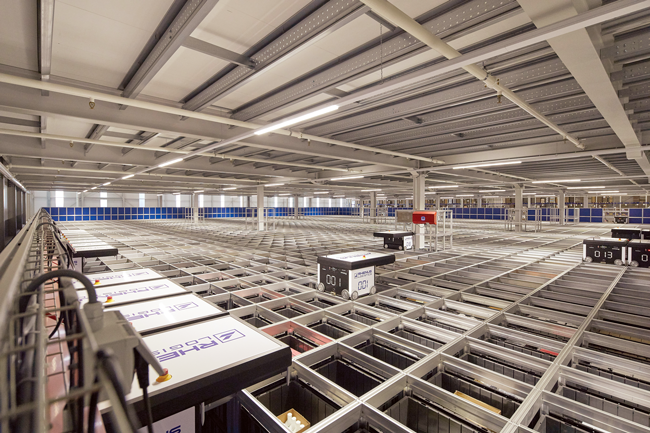
Wheeled robots drive along an overhead grid to pick up products from storage bins at Rhenus Logistics' facility in Tilburg, Netherlands. (Rhenus)
Although Bleckmann shies away from adopting fully automated systems at its distribution center, the company does incorporate digitization to enhance operating efficiencies. Fulfillment employees carry iPads to interact with the Apple iOS-based warehouse management system, and supervisors track their group’s performance statistics hourly on a central screen. This reflects the broader trend of Dutch freight businesses steadily incorporating greater data-driven and connected operations infrastructure.
The Netherlands has a high rate of internet connectivity and speed, due in large part to 11 of the 15 trans-Atlantic undersea cables coming ashore in the country. The internet access and connectivity allow businesses to optimize their business models by converting manual processes to digital and utilizing rapid cloud computing and storage.
Schiphol airport’s customs opened a new joint inspection center three years ago to integrate digital cargo inspection and monitoring. Data gathered from cargo scans receive further analysis in centralized control rooms, and suspicious shipments are flagged for on-the-ground inspections. Customs employees scan for illegal drugs, weapons and nuclear items, among other things. The inspection center is part of the greater SmartGate Cargo initiative to speed freight flow while still enhancing safety.
At the Port of Rotterdam, the greater use of data “helps with the flawless flow of goods,” said Steven Jan van Hengel, senior business manager for shippers and forwarders at the Port of Rotterdam.
The port uses a door-to-door route planner to help shippers find the most efficient way to transport their containers, in addition to a software platform that offers easy access to container data and tracking.
It’s also partnering with the city on a blockchain incubator project. This summer, the port accepted its first container fully managed via blockchain. The container traveled from South Korea through the Port of Rotterdam and to a warehouse in Tilburg using completely paperless documentation and payments while providing door-to-door shipment visibility. Further freight testing is underway, as is testing for other blockchain applications such as a decentralized energy grid.
Technology companies and educational institutions are coming together to recruit and produce the next generation of tech-savvy logistics workers as freight companies’ demand for them grows. For example, the Brainport Industries Campus in Eindhoven is a hub for innovation in high-tech manufacturing and logistics. It serves as a knowledge-sharing institution for optimal manufacturing, inventory and supply chain planning, as well as a testing environment for robotics and automated vehicles.
Rhenus’ push for automation and digitization prompts the need for more high-skilled labor to facilitate the “shift from physical handling to a data-driven company,” van Erven said. But even its traditional packing and distribution workers are expected to be of a superior caliber.
The company packages and distributes many high-priced med-tech items, such as heart valves and artificial veins, that require care and precision in handling. Therefore, it installs cameras over each packing workstation to film workers and gather data. The order only will be released if the data matches an order’s specifications. Every product has an RFID label and is transported via air because of the time restrictions and value of the cargo.
Setting Sights on Sustainability
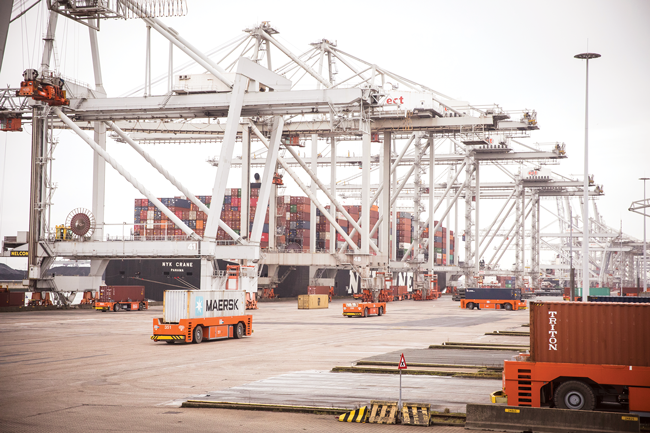
Automated guided vehicles carry containers at the Port of Rotterdam. The port also utilizes route planning and tracking software to streamline cargo transportation. (Rotterdam Partners)
Transporting goods from point A to point B is one thing, but doing so sustainably is completely another. Freight notoriously is viewed as an industry with a large carbon footprint, but companies and governments increasingly are transitioning to less environmentally taxing modes of operation.
A well-known example is the International Maritime Organization’s regulation mandating that the marine sector switch to low-sulfur fuels to achieve an 80% reduction in sulfur emissions starting Jan. 1.
The Netherlands, meanwhile, committed to climate action goals under the Paris Agreement and this summer passed its own national Climate Agreement.
The Port of Rotterdam is getting in on the sustainability game through a number of measures such as more efficient, dimmable LED lighting. Windmills installed in numerous clusters on the port’s expansive property aid in the transition to renewable energy and reducing carbon emissions.
The distribution center Rhenus Logistics opened last year in Tilburg has been lauded as one of the most innovative and sustainable in the world. It received a 99.48% rating based on the Building Research Establishment Environmental Assessment Method, or BREEAM, for an industrial building — the highest score ever achieved.
The 650,000-square-foot facility employs dimmable LEDs, heat air pumps and collected rainwater to flush toilets. It is chock full of sensors to automatically control internal environmental conditions, which boosts efficiency and cuts energy use.
But perhaps the most noticeable element is the roof-mounted solar farm. The facility houses more than 13,600 solar panels that generate 4.2 megawatts of energy annually. Because Rhenus currently uses less than 1 megawatt annually to operate the facility, it sells the excess energy back into the Netherlands’ power grid.
At another facility, Rhenus is testing more sustainable packaging systems, including machinery that makes boxes precisely fitted to a product. The custom boxes use less cardboard and no air cushions, plus more goods can fit into a truck to optimize utilization of cargo space.
Freight companies in the Netherlands and beyond increasingly combine such sustainability measures with digitization and automation in their future planning to create holistic, integrated systems.
And that’s crucial because the supply chains of the world “have become more and more integrated,” de Jonge said.
Want more news? Listen to today's daily briefing:


